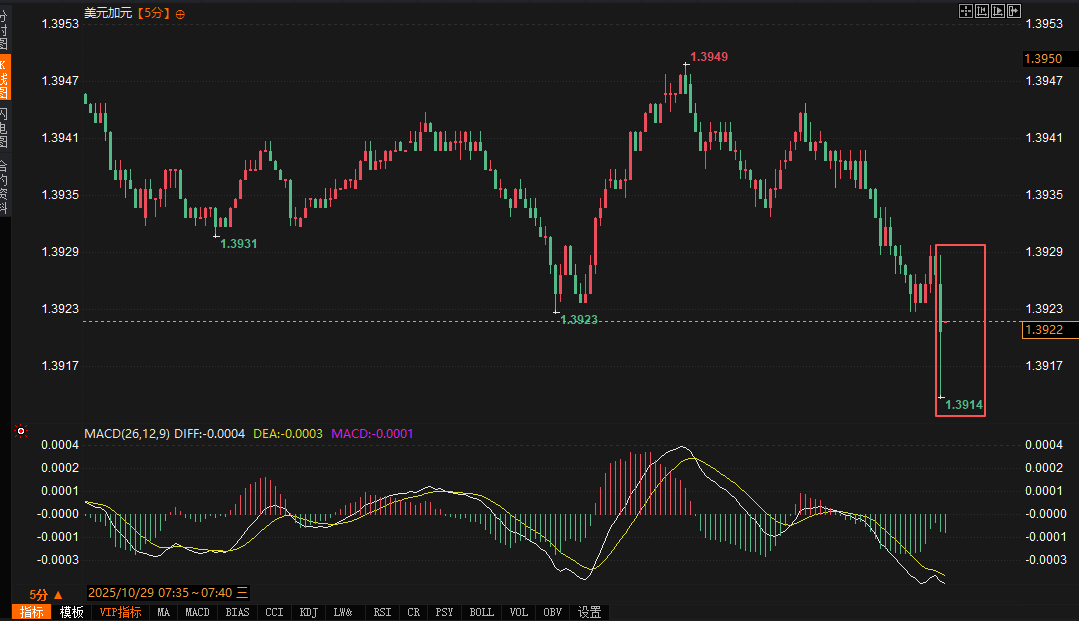The Bank of Canada preemptively cut interest rates by 25 basis points, bringing the USD/CAD pair to a critical juncture for bulls and bears!
2025-10-29 22:01:15

Meanwhile, September's CPI inflation rate was 2.4%, slightly higher than the central bank's previous forecast, but core inflation remained stubbornly hovering around 3%, while underlying inflation remained stable at 2.5%. This combination of measures, while not unexpected, quickly ignited market sentiment against the backdrop of trade uncertainty and a weak labor market. The USD/CAD pair briefly dipped 11 points, touching a low near 1.3850. The Canadian dollar rebounded briefly but remained under pressure overall, highlighting investors' cautious optimism regarding the "structural adjustment" phase of the Canadian economy.
The "stickiness" of core indicators has become a consensus, and the central bank also acknowledged in its report that its preferred core inflation measure remains within the 3% range. Retail traders were cautious in the morning, with one veteran forex enthusiast posting: "The CPI month-on-month increase exceeded expectations; will the Bank of Canada think twice tonight? The Canadian dollar may hold the 1.39 level." Institutional opinions were more divided. Analysts from well-known investment banks pointed out that the unexpected rebound in September's employment data (more than expected new jobs) coupled with a slight increase in inflation may prompt the central bank to strengthen its "data-dependent" tone in its statement, avoiding market interpretation as "unlimited dovishness." In contrast, the market had already priced in an 88% probability of a 25 basis point rate cut before the data release. Although the OIS curve briefly shifted upward, the overall expectation remained unchanged—the unemployment rate remained at a cyclical high of 7.1%, and continued job losses in trade-sensitive industries overshadowed inflationary noise. One market intelligence account summarized: "The CPI exceeded expectations, but soft employment remains a constraint for the Bank of Canada; compared to the optimism before the July decision, today's pricing is more realistic."
Following the resolution, the market reacted swiftly yet restrainedly. The USD/CAD pair plummeted from a high of 1.3880, testing support at 1.3840, with trading volume surging 20%, reflecting immediate short covering. The Canadian dollar strengthened slightly by 0.2% against the US dollar but failed to break through the psychological level of 1.3900, suggesting that traders viewed this as a "technical correction" rather than a directional reversal. In the bond market, the yield on Canadian 2-year government bonds rose 5.2 basis points to 2.406%.

Some retail traders are worried: "With core inflation remaining at 3%, is the Bank of Canada paving the way for the Fed? The Canadian dollar may struggle to recover amid trade frictions." Institutional investors are more rational. A well-known strategist commented: "The decision was in line with expectations, but the MPR's downward revision of 2025 GDP growth to 1.2% (a 0.6 percentage point decrease from the January report) highlights the drag on exports and investment from trade actions; a 'soft landing' for the labor market is key. If the November non-farm payrolls report continues its weakness, the Bank of Canada may restart discussions on interest rate cuts." Another global bank emphasized: "The central bank acknowledged core inflation at 2.5%, but expects pressure to ease in the coming months—a stark contrast to concerns about a 'hawkish surprise' before the data release, shifting market sentiment from cautious to neutral."
The underlying logic of this rate cut is inextricably linked to the Federal Reserve. The market priced in a near 25 basis point rate cut at Thursday morning's FOMC meeting, with the federal funds rate potentially falling to 4.00%-4.25%. The Bank of Canada's move is seen as an "early follow-up," aiming to narrow the interest rate differential between Canada and the US dollar (currently the federal funds rate is 4.25% vs. the Bank of Canada's 2.25%, widening the differential to 200 basis points) and alleviating capital outflow pressures. Historically, in 2024, the Bank of Canada twice "led" the Fed's rate-cutting path, causing the USD/CAD exchange rate to plummet from a high of 1.42 to a low of 1.35, a cumulative depreciation of over 500 points.
This time, the uncertainty surrounding trade has amplified – the central bank report directly points to the impact of “US trade actions” on industries such as automobiles and steel, lowering global growth forecasts from 3.25% in 2025 to 3%. Institutional accounts have picked up on this trend, with one macro analyst posting: “The Bank of Canada’s statement that ‘reshaping trade relations is suppressing investment’ echoes the potential downward revision of the Fed’s dot plot; before the data release, market bets on the Bank of Canada pausing trading were high, but sentiment reversed after the decision, and short positions in USD/CAD were reignited.”
Retail investors were even more blunt: "The Canadian economy is like the shadow of the Federal Reserve; the interest rate cut is to pay for risk aversion—Trump's tariff rhetoric has once again stirred things up, and the strong dollar may continue until Thanksgiving."
From a broader perspective, the Bank of Canada's action will have an impact on market trends beyond immediate fluctuations; it will reshape the anchor of expectations. In the short term, the Canadian dollar's movement will closely follow the Federal Reserve's statement—if Powell reinforces the "gradual rate cuts" rather than a "sharp turn," the USD/CAD pair may fluctuate between 1.38 and 1.40, with the 50% Fibonacci retracement level of 1.3820 acting as key support. A flattening yield curve suggests a slowdown in growth to 1.1% in 2026, but a recovery in residential investment and consumption may provide a buffer; the central bank expects excess capacity in the economy to be "gradually absorbed," which is consistent with historical cycles—during the peak of trade frictions in 2019, the Bank of Canada stabilized the unemployment rate through three rounds of rate cuts, avoiding a hard landing.
Overall, the market reaction shifted from a brief hawkish surprise following the data release to a dovish confirmation after the resolution was announced. The interplay of interest rate differentials and risk aversion drove a slight recovery in risk assets, but the "structural damage" of trade frictions remains a looming threat, limiting bullish momentum.
Looking ahead, the Bank of Canada's path may gradually align with that of the Federal Reserve, but Canada's unique challenges will amplify the divergence. The projected moderate GDP growth of 1.6% in 2026 depends on stabilizing exports and investment. If the Russia-Ukraine situation continues to disrupt the energy supply chain, oil price volatility could push up imported inflation, testing the central bank's "response preparedness." In the short term, if the USD/CAD pair holds above 1.38, traders can position for a rebound to 1.3950, taking advantage of the Fed's rate cuts; however, if trade negotiations stall, the probability of testing the 1.40 level rises to 60%. From a long-term perspective, the Bank of Canada emphasizes "price stability confidence" to weather "global turmoil," consistent with historical experience—during the 2015-2016 oil price collapse, the central bank stabilized inflation through forward guidance, preventing a vicious cycle. In a game of narrowing interest rate differentials and uncertainty, close monitoring of November's labor market data and trade negotiation progress is crucial to grasping the rhythm of this "structural adjustment."
- Risk Warning and Disclaimer
- The market involves risk, and trading may not be suitable for all investors. This article is for reference only and does not constitute personal investment advice, nor does it take into account certain users’ specific investment objectives, financial situation, or other needs. Any investment decisions made based on this information are at your own risk.





















